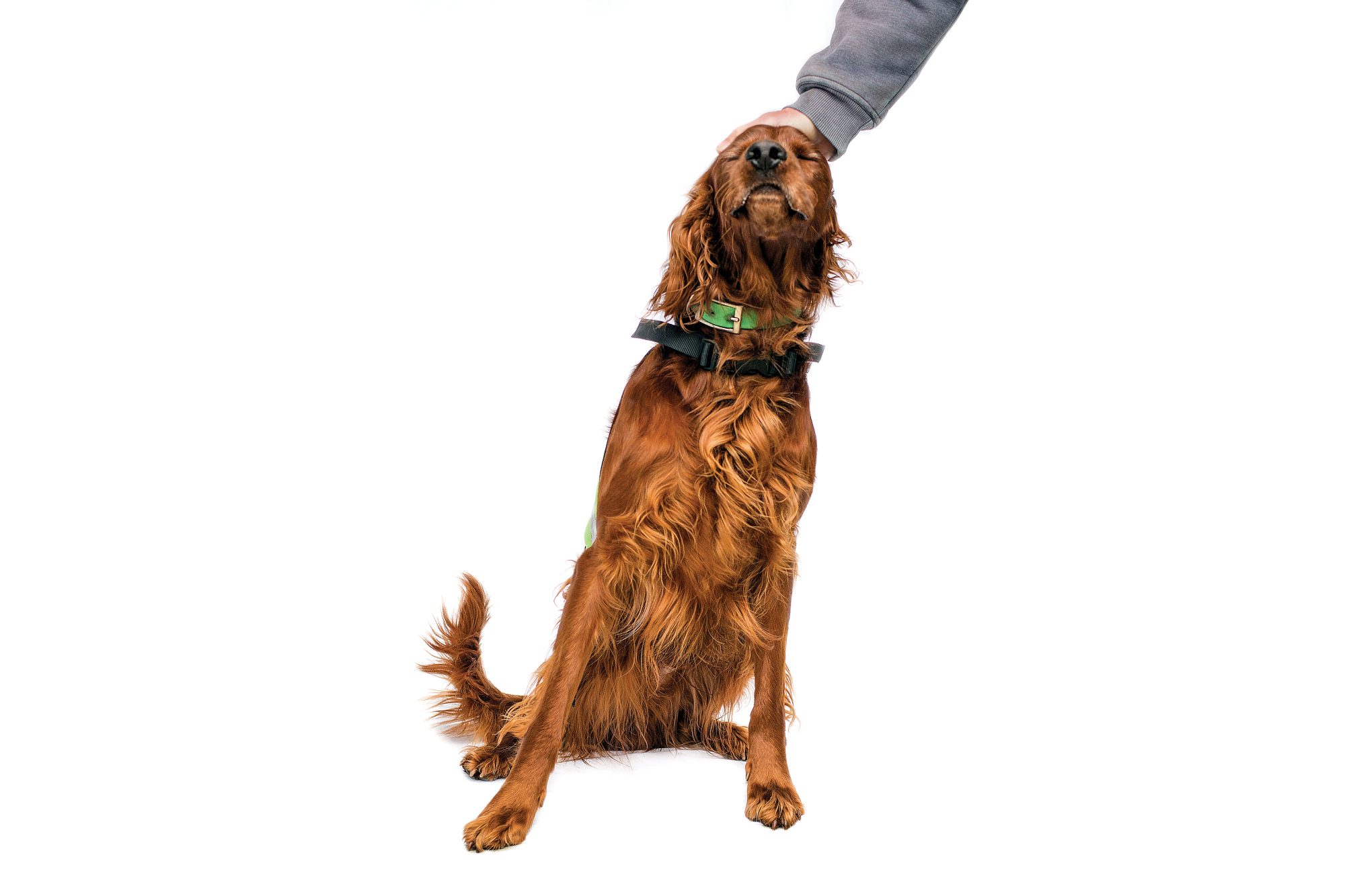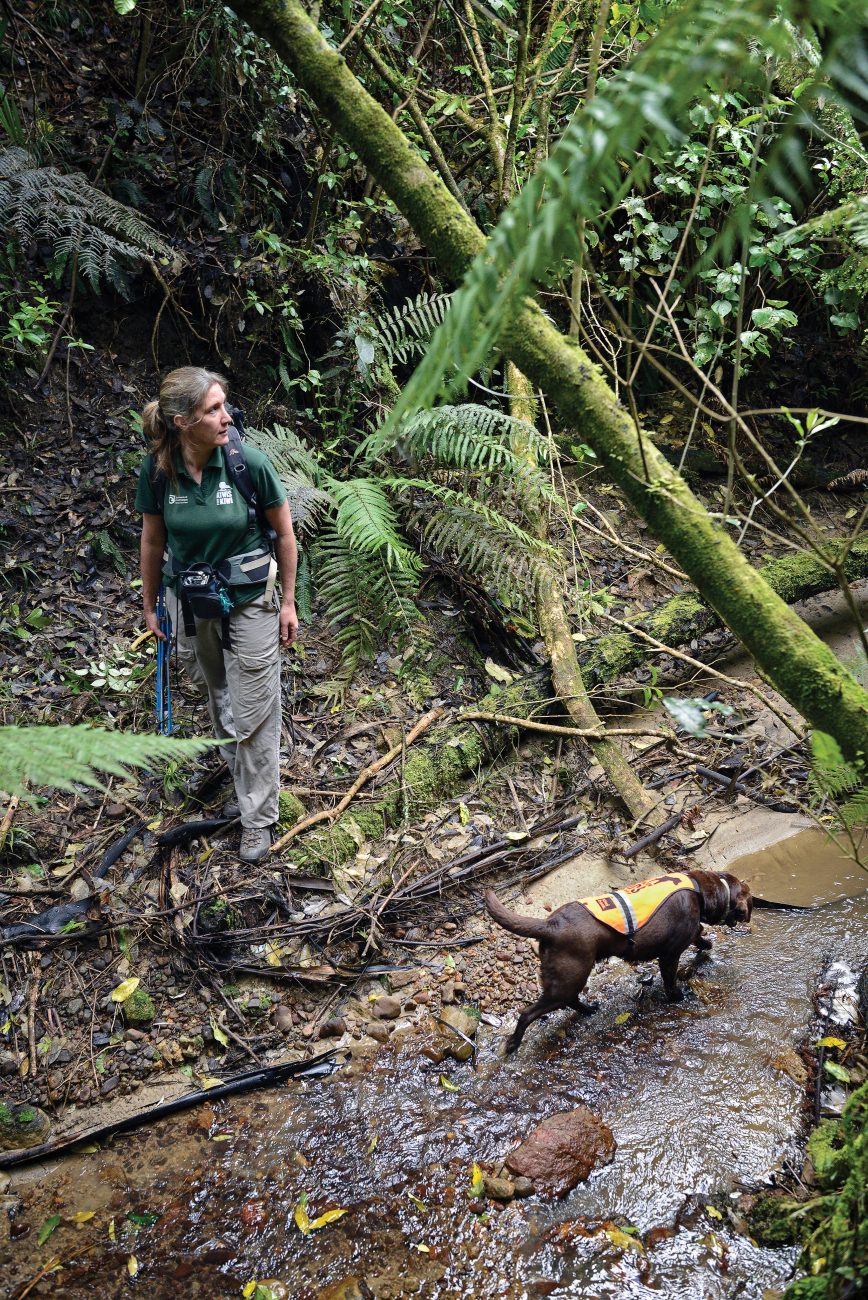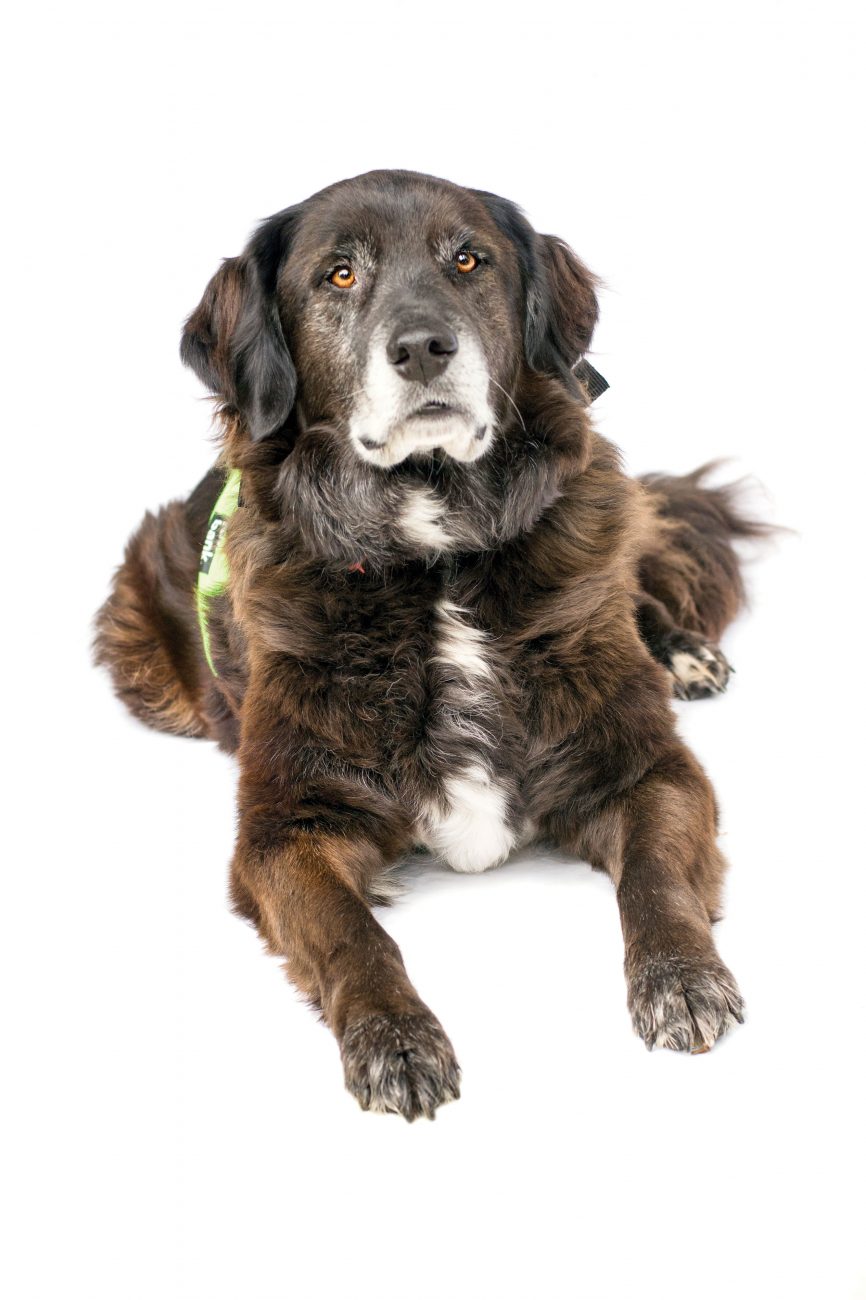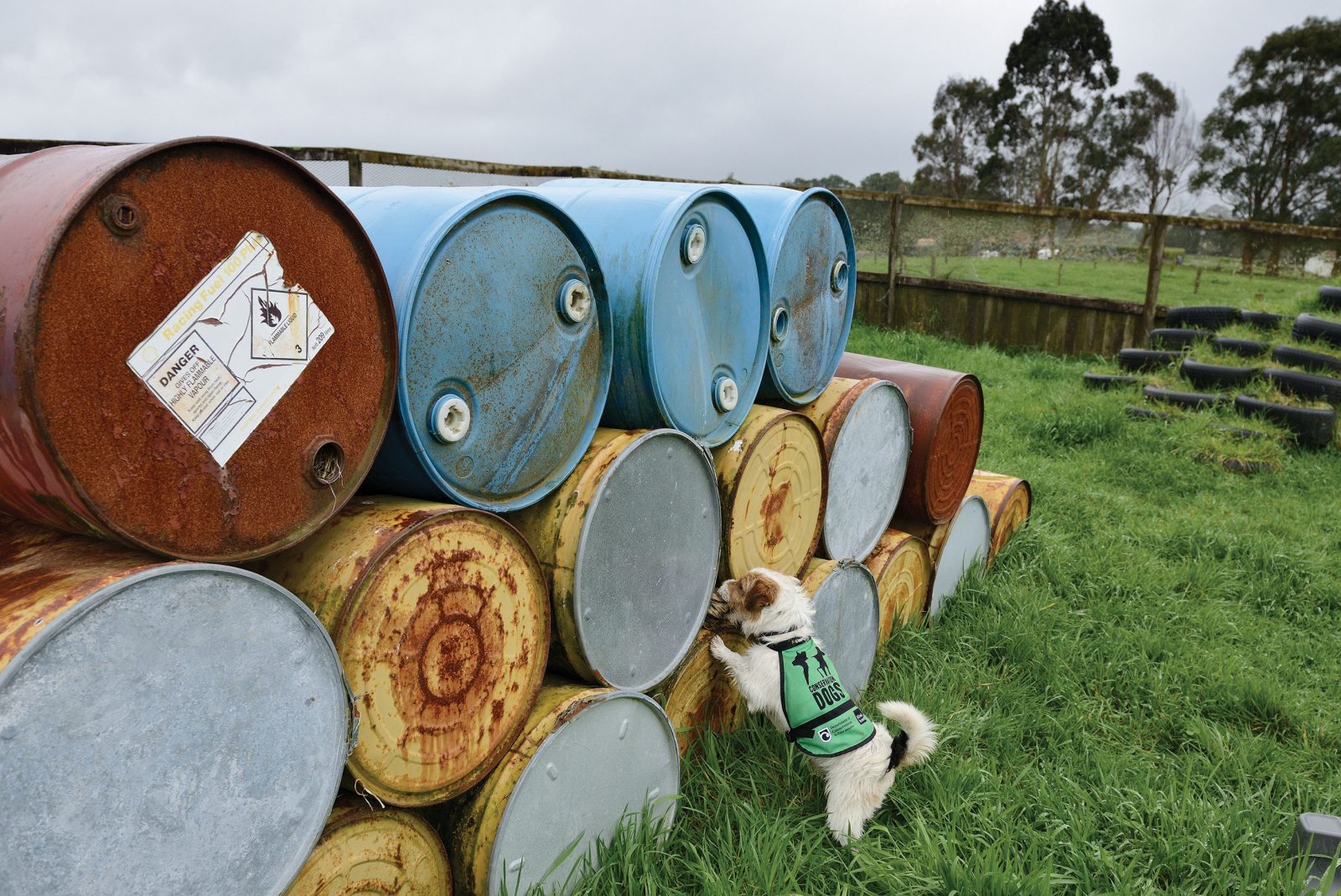
Track and trace
Most introduced mammals have had a devastating effect on native wildlife, but one species is bucking the trend. About 80 conservation dogs are deployed around the country, helping to protect vulnerable native species by leaping into action at a single command: Seek!

Sunlight sifts through the canopy of pōhutukawa, catching the Labrador’s sleek chocolate fur. Her nose traces a meandering path through the leaf litter, punctuated by the odd snort. As she trots, combing the base of a gully, her whole body sways from side to side, her tail wagging gently in time with her gait.
She shifts direction and begins to climb one side of the gully—then pauses mid-step, glancing back over her shoulder to check she’s being followed.
“Good girl, Aria,” calls Bridget Palmer. “Walk on.”
The dog scales the side of a spur, climbing until she reaches a particularly dense tangle of undergrowth. She lowers her nose to the stack of sticks and bracken and waits.
The climb takes Palmer longer—the spur is near-vertical in places, coated in slick leaf litter and mud. Hanging on with one hand, she reaches upwards into the tangle of twigs, groping, her face taut with determination. When she withdraws her arm, she has a wriggling ball of silvery-brown fur in hand.
The North Island brown kiwi, a young male named Scrum, has the crumpled head-plumage and unimpressed expression of someone disturbed from a nap. Aria watches him intently, but her rump is planted firmly in ‘sit’. Her nose twitches beneath her muzzle.

After an upside-down weigh-in and a once-over for mites and parasites, Scrum is returned to his refuge. The kiwi of Ōhope Scenic Reserve are intensively managed in situ—Aria, Palmer and a band of volunteers regularly track each one down to make sure it’s doing okay.
Finding kiwi is tricky business. Many are radio-tagged, meaning it’s possible to find their general location by listening with an aerial, but pinpointing their exact spot can be a challenge. By day, they sleep hidden deep inside burrows, some as precariously located as Scrum’s.
“It’s very difficult for us to get close without making a lot of noise, but the dog will go in quietly and point exactly where to move in,” says Palmer, team leader of the Whakatāne Kiwi Trust. “I’ve seen plenty of birds run when it’s humans trying to catch them, but I’ve never seen one run with a dog.”
Palmer says kiwi dogs such as Aria are most useful for finding unknown kiwi, or birds that have dropped their transmitter.
“That’s the proudest I’ve been—when she finds birds that I don’t know about.”
As a rule, dogs aren’t allowed on conservation land—their propensity for chasing birds ruffles more than a few endangered feathers—but Aria is one of about 80 conservation dogs, each rigorously trained to seek a particular species.
About 35 of the dogs track introduced predators, such as rats, stoats, and feral cats. The remainder seek out threatened native species—those which have dwindled to such scant populations that intensive management is necessary. Kākāpō, takahē, whio, pāteke and kea are all closely monitored in order to learn how the birds are coping in the wild.

Detection dogs are widely considered more efficient than other surveying methods, and they’re accurate, too. A study examining detection rates for tuatara and gecko dogs found they could differentiate even between different reptile species, and had average success rates of 86 to 98 per cent.
Dogs are particularly useful for finding nests, allowing rangers to track how many chicks survive to join the adult population. Ajax the kea dog indicates when a burrow is occupied, while Paikea the takahē dog makes it easy to find nests hidden in thick tussock.
Many handlers have stories about their dogs finding birds that human senses missed. The little blue penguin dog, Mena, once adamantly indicated a patch of long grass—far from typical penguin habitat. Sure enough, she’d found a nest.
[Chapter Break]
Dogs are employed in more than 30 occupations around the world that depend on the power of their noses, from snuffling truffles to busting drug smugglers. Including them in conservation work was a New Zealand invention.
Richard Henry, arguably the country’s first wildlife ranger, noticed the devastating effect mustelids were having on native birds in Fiordland in the 1890s, so he began translocating any birds he could catch to Resolution Island. To track down kiwi and kākāpō, Henry deployed one of his dogs, outfitted with a muzzle and bell, and followed its tinkling sound through the bush.
Sadly, Resolution Island is within swimming distance of the Fiordland coast, and before long, weasels crossed to the sanctuary and began to eat its occupants.
The next effort to translocate kākāpō to safety wasn’t until the 1970s. Intensive search efforts failed to turn up even one female—but where human eyes failed, a dog’s nose prevailed. Jasper the spaniel led searchers to the first female kākāpō spotted since the days of Richard Henry. Of the 86 kākāpō captured in the 1980s, Gary Aburn and his dogs caught 46.

While detection dogs are now found all over the world, New Zealand is the only country with a national programme and certification system—which began in 1998—and our dogs are in demand overseas.
Many of the dogs deployed in the wake of mammoth pest-eradication efforts on Australia’s Macquarie Island were provided by New Zealand trainers. One dog, a border-fox terrier cross named Tama, was a failed rodent-detection dog who hadn’t been able to overcome his love of chasing rabbits. So he joined the rabbit-detection team—and it proved to be the second chance he needed at a career. (Ironically, Tama is now a rodent-detection dog in Tasmania.)
New Zealand has exported its dog technology around the globe: a rabbit-detection dog now residing in Chile, cat dogs to Australia, and mongoose-scenting dogs to Japan. Soon, an Argentine-ant detection dog will be shipped to Norfolk Island—only the second dog in the world with this capability, the first having also been trained in New Zealand. Back on home soil, conservation dogs are trained for ever-more-unusual targets, such as kauri dieback and whitebait.
[Chapter Break]
Dark, wet, rough and twitching, the dog has a point-of-nose perspective humans only get a whiff of, a scent-picture of the world that is composed of chemicals rather than light. A dog’s sense of smell is anything from 10,000 to 100,000 times more sensitive than our own. The measurement is inexact, because our tools aren’t sensitive enough to describe it more precisely.

Think of it like this: if you can smell when someone takes off their shoes in the living room, a dog could smell the same release of pungent foot odour from anywhere within New Zealand’s largest shopping mall.
The shape of a dog’s nose bestows it with this superpower. While we possess some six million olfactory receptors, dogs have 300 million. Our receptors are bunched up in a small region along the main airflow path, whereas in dogs, some of the airflow is siphoned off into a special smell-nook, where odours are sifted through bony filters, like krill through a whale’s baleen. Then, when we exhale, there is only one path out, forcing all incoming smells to vacate the nostrils. When dogs exhale, they push the air out slits in the side of their nose, leaving a clear path for incoming scents to brew.
[Chapter Break]
The boat rolls with the ocean past Shingle Point on Mana Island, off the Kāpiti Coast. Shags line the stony strip of beach beneath a sagging slate-grey sky.
DOC dog handler Miriam Ritchie and contractor Leona Plaisier are here for routine surveillance—checking no stoats or rats have made their way to this slab of rock in the Tasman Sea. We spot kākāriki, takahē and pūkeko, as well as seabird nesting boxes and Cook Strait giant wētā. Little spotted kiwi and pāteke live here, too.
Ritchie has a smile-lined face and a bobbed muss of hair pulled away from her eyes with a snap hairclip. She has two dogs in tow: Ahu, a tan-coloured, rodent-sniffing border terrier, and Woody, a dark, wiry-coated, stoat-detecting jagdterrier. Ahu is a real charmer. Whenever we stop, he’ll roll over to receive tummy tickles and ear scratches.
“He’s got those come-hither eyes,” says Ritchie.
A couple of times, I see Ahu stop and take a big inhale and wiggle his nose inquisitively. Could that be a rat? Nope, says Ritchie.
“Ahu will get sort of frantic, and his antics change. He’ll start hunting around, trying to find where it comes from. He’ll get really animated, round and round and round.” Woody, on the other hand, becomes more intense. “He just starts creeping.”

Pest-detection dogs are instrumental in safeguarding New Zealand’s predator-free islands and sanctuaries. They’re most useful when predator numbers are so low that baiting and trapping no longer work. (When a single stoat wiped out the saddleback population at Orokonui Ecosanctuary near Dunedin, a conservation dog found its nest.)
Pest dogs don’t kill animals, but indicate their presence—which means they almost never encounter their target while on the job.
“We use terriers because that’s their nature to catch little things and they get very, very revved up about it,” says Ritchie.
“So, it’s a big responsibility using them in places with endangered species. Obviously, they have to be certified, so we’ve tried and tested that they’re not going to chase things. But they’re still dogs and this is why they’re muzzled. If something flushed across the track, like weka, before the dogs can even think, their instinct says, ‘Grab’.”
Earlier in the year, Plaisier and her main dog, Bail, made an exciting find on Ohinau Island, part of the Mercury Islands group, just off the coast of Coromandel.
Her dog had indicated, and not long after, an avocado with suspicious teeth marks was found by seabird scientists. Eventually, the perpetrator was caught: a Norway rat of monster proportions, weighing in at 604 grams.
“In eight years of working, we finally found something that wasn’t supposed to be there,” she says. “To my delight, they got it stuffed. I couldn’t believe it. I hadn’t seen the rat; the dog had only indicated. They got him in a trap which hadn’t even properly caught him. It just clapped him on the head and he died of fright.”
[Chapter Break]
The stereo loops a soundtrack of traffic, yelling, and gunfire, and the sounds reverberate around the cavernous barn.
“The dogs have to get used to all kinds of environments,” explains Guus Knopers, “where they might be working.”
Knopers trains dogs for anything and everything. Here, there are athletic police dogs, floppy-eared drug-detection spaniels, and biosecurity mutts rescued from the pound. Large-and-in-charge Belgian Malinois are destined for security work or the armed forces, while conservation-dogs-in-training are learning to detect targets including alpine newts, plague skinks, wallabies, Argentine ants, passionfruit, rodents and mustelids.

It’s a rigorous process of daily practice that takes up to 18 months, although it varies from animal to animal.
“Some dogs learn very quick, other dogs take a little bit longer, and some are just not the right dogs,” says Knopers.
Dogs only receive full certification once they have been trained to find their target and only their target—no chasing after delicious off-target smells, like Tama the rabbit-mad rat dog.
In a back room of the barn, buckets line one wall. Dog trainer Kerryn Johnson leads out a tiny, white-and-brown springer spaniel with a stumpy tail.
“This is Aspen,” says Johnson. “She’s one year old, she’s just a beginner.”
Aspen wags her tail so hard that her entire body wiggles. She presses her wet nose to the back of my hand, then turns back to Johnson.
A small plastic container holding a tiny brown skink is in one of the buckets, along with Aspen’s favourite ball. Her target is a plague skink, an invasive import from Australia which breeds prolifically.
“Seek!” commands Johnson.
Aspen is off, speedily nosing each bucket. As soon as she descends on the target bin, Johnson erupts with praise. Aspen proudly holds her ball in her mouth as she is lavished with pats and cuddles. I’m surprised by the split-second turnaround between Aspen reaching the target and receiving her reward, but Johnson explains it should come within three seconds of carrying out the desired behavior.

Eventually, Aspen will move on to boxes containing just the skinks—no ball—then boxes with a series of target and non-target odours, which she’ll have to differentiate between. Incredible what a dog will do, all for the love of a ball game.
“There’s so much dogs can do that we don’t know about,” says Knopers. “We’re still finding out new things.”
Psychologists test for self-awareness using a mirror—to see if subjects can recognise the individual in the reflection as themselves. Humans older than age three, chimpanzees and dolphins have all passed the test, but dogs fail—so does this mean they’re not self-aware?
When the test is redesigned to depend on smell rather than sight, dogs pass easily. They will spend a long time sniffing other dogs’ urine, but skip their own, because, researchers surmise, they see it as theirs.
Meanwhile, people are finding new ways to capitalise on dogs’ sense of smell—increasingly for medical purposes.
Dogs can be trained to detect the chemicals that arise from subtle biochemical changes, meaning they can pick out cancer, or alert a person when a seizure, migraine or episode of narcolepsy is imminent.
Around the back of the barn is where the real training magic happens. It’s a full-blown arena, complete with a Tux Wonder Dogs-style obstacle course, plus hidey-holes for targets at different heights. Here, we meet Bond, a muscly German short-haired pointer.

“We call him ‘the body builder’,” says Johnson. Bond was rescued from the pound and transported to his new life as an alpine-newt detection dog.
“Seek!”
Bond methodically checks each location. At one, he goes to sit, but his rump hovers just above the ground and he stamps his feet in a dance of anticipation. This amusing performance is Bond’s indication. He’s found the newt. Within seconds, a ball lands in front of him and he’s off in a game of fetch.
“There’s no malice in it,” says Knopers. “It’s all just a big game.”
















